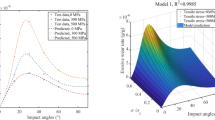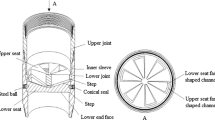Abstract
Under the condition of nitrogen drilling and blowout in an oilfield, the high-speed gas carried cuttings to the wellhead equipment, causing erosion and wear damage to different degrees, especially the erosion and wear of the wellhead four-way bypass. To explore the erosion wear law of the wellhead four-way and slow down the wear rate, based on the erosion failure mechanism of gas–solid two-phase flow, this paper uses the CFD simulation software to establish a wellhead four-way fluid domain model and analyzes the erosion and wear causes of the four-way bypass. And studying the erosion and wear law of the wellhead four-way bypass under different gas blowout amount, cuttings mass flow rate, cuttings diameter and cuttings density. Then, the erosion resistance of Ni60, Ni45 and Inconel625 coating materials was analyzed through experimental research, and the erosion resistance coating on the inner wall of the wellhead four-way was optimized. The results show that: (1) With the increase of natural gas emission amount, cuttings content, and cuttings diameter, the bypass erosion rate increases; the cuttings density has no obvious effect on the erosion rate; (2) The coating material with the strongest erosion resistance is Inconel625, followed by Ni45, and Ni60 has the worst erosion resistance.













Similar content being viewed by others
References
WC. Lyons, B.G, F.A Seidel: Air and gas drilling manual : engineering applications for water wells, monitoring wells, mining boreholes, geotechnical boreholes, and oil and gas recovery wells [J]. (2001)
C. Aimin, Discussion on technical process and design of gas drilling technology [J]. Heilongjiang Sci. Technol. Inform. 36, 92 (2009)
G. Jian-hua, L. Qian, W. Jin, L. Qiang, X. Yan, Research on cuttings migration mechanism in gas drilling [J]. Natural Gas Indus. 06, 66–67 (2006)
X.D. Zhang, C.D. Wu, Analysis of erosion wear mechanism of drilling tools in air drilling [J]. J. Southwest Petrol Univ (Sci Technol Edition). 31(02), 139–142 (2009)
L. Huixin, M. Yingfeng, Experimental study on annular rock carrying flow in air atomization drilling [J]. J. Southwest Petrol Inst. 03, 34–36 (2001)
M.P Sharma : A microcomputer model for cutting transport in air drilling; proceedings of the Petroleum Industry Application of Microcomputers, F, 1987 [C]. SPE-16500-MS
Y. Jianlin: Annular flow field analysis and erosion characteristics of cuttings on pipe string in gas Drilling [D]; Shanghai University, (2011)
L. Hongbin, M. Hao, L. Shitou, Z. Yihao, Lubr. Eng. 44(01), 81–88 (2019)
L. Aijun, Study on borehole stability in air drilling [J]. West China Exploration Eng. 01, 11–14 (1994)
J.X. Zhang, Y.Q. Bai, J. Kang, W. Xuan, Failure analysis and erosion prediction of tee junction in fracturing operation [J]. J Loss Prevent Process Indus. 46, 94–107 (2017)
H. Xiao-bing, C. Ci-chang, D. Yao-wen, Natural Gas Industry. 28(11), 83–84 (2008)
J. Chen, Y. Wang, X. Li, R. He, S. Han, Y. Chen, 2015, Erosion prediction of liquid-particle two-phase flow in pipeline elbows via CFD-DEM coupling method [J]. Powder Technol: An Int. J. Sci. Technol. Wet Dry Particulate Syst. 275, 182–187 (2015)
Z. Zhou, D. Gong, Z. Zeng, T. Lin, Failure analysis of a four-way flange erosioning in a KQ52 wellhead christmas tree [J]. Eng. Fail. Anal. 129(4), 105641 (2021)
S.M. Ziaei, A.H. Kokabi, M. Nasr-Esfehani, Sulfide stress corrosion cracking and hydrogen induced cracking of A216-WCC wellhead flow control valve body [J]. Case Studies Eng Failure Anal. 1(3), 223–234 (2013)
M. Pan, L. Zhiping, J. Mater. Sci. Eng. 03, 92–96 (1999)
P. Junfeng, W. Bing, Y. Shunshi, Q. Zhijian, S. Jinhai, X. Yanhai, J. China. Univ Petrol (Edition of Natural Science). 42(03), 122–130 (2018)
W. Zheng: FLUENT Fluid calculation application tutorial. 2nd edition [M]. FLUENT Fluid Computing Application tutorial. 2nd edition, (2013)
J.G. Collier, J.R. Thome, Convective boiling and condensation [M]. (Clarendon Press, UK, 1994)
Q.Q. Lu, J.R. Fontaine, G. Aubertin, A Lagrangian model for solid particles in turbulent flows [J]. Int. J. Multiph. Flow. 19(2), 347–367 (1993)
J.K. Edwards, B.S. McLaury, S.A. Shirazi, Modeling solid particle erosion in elbows and plugged tees [J]. J Energy Resour Technol. 123(4), 277–284 (2001)
ASTM G76 : Standard test method for conducting erosion tests by solid particle impingement using gas jets [M]. ASTM International West Conshohocken, PA. (2004)
Author information
Authors and Affiliations
Corresponding author
Additional information
Publisher's Note
Springer Nature remains neutral with regard to jurisdictional claims in published maps and institutional affiliations.
Rights and permissions
Springer Nature or its licensor (e.g. a society or other partner) holds exclusive rights to this article under a publishing agreement with the author(s) or other rightsholder(s); author self-archiving of the accepted manuscript version of this article is solely governed by the terms of such publishing agreement and applicable law.
About this article
Cite this article
Yunda, Y., Xiaolan, Z. & Yang, Y. Study on Erosion Wear Law and Anti-Erosion Ability Optimization of Wellhead Four-Way. J Fail. Anal. and Preven. 23, 234–244 (2023). https://doi.org/10.1007/s11668-022-01548-w
Received:
Accepted:
Published:
Issue Date:
DOI: https://doi.org/10.1007/s11668-022-01548-w




